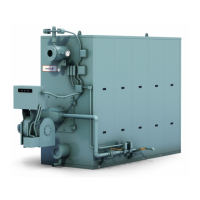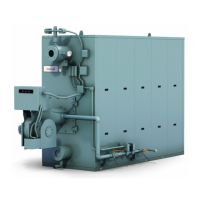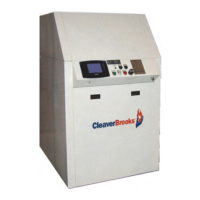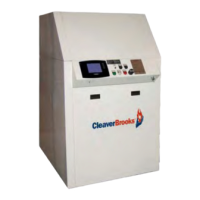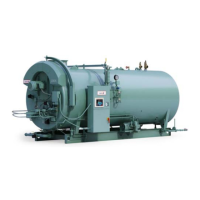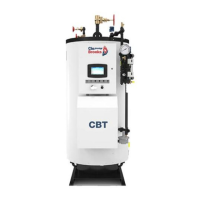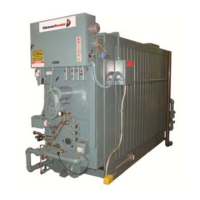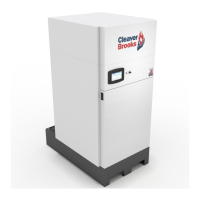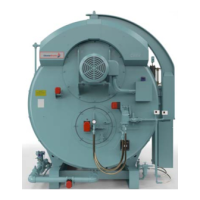STARTING AND OPERATING INSTRUCTIONS Chapter 5
750-177 5-19
The method for regulating the fuel-oil flow rate (nozzle
pressure) is as follows:
1. Maximum flow rate is established by operating the
burner at high-fire with the oil metering valve in a nearly
closed position with the modulating motor set at the
high-fire position. In this position, the flow of fuel oil
through the oil by-pass is minimal, resulting in nearly
maximum flow pressure from the pump. High-fire oil
flow adjustment is accomplished by adjusting the
linkage to the oil metering valve so that the burner nozzle
pressure equals the maximum oil pressure specification
on the burner data plate (see Figure 5-8).
2. Oil pressure modulation for turndown to low-fire
operation is accomplished by increasing the flow rate of
oil through the oil by-pass loop, which reduces pressure
in the burner nozzle. This is accomplished by setting the
modulating motor to the low-fire position, which causes
the oil metering valve to open. While in this position, the
oil metering valve linkage can be adjusted so that the
burner nozzle pressure equals the minimum oil pressure
specification on the burner specification plate (see
Figure 5-8).
F. STARTUP, OPERATING AND
SHUTDOWN - ALL FUELS
Depending upon the fuel being burned, the applicable
previous sections in Chapter 5 should be reviewed for
preliminary instructions.
The fuel selector switch should be, accordingly, set to either
oil or gas.
Set the manual-automatic switch (Figure 2-1) to “manual”
and turn the manual flame control to “close.”
Turn burner switch to “ON.” The load demand light should
glow. The low-water level light should remain out, indicating
a safe water level in the boiler. The programmer is now
sequencing. See Chapter 4 for sequence details.
Note: On an initial starting attempt, several
efforts might be required to accomplish
“bleeding” of fuel lines, main or pilot. If
ignition does not then occur, do not repeat
unsuccessful attempts without rechecking
the burner and pilot adjustment.
On ignition failure, the flame failure light will glow and the
blower will purge the boiler of unburned fuel vapors before
stopping. After ignition failure, wait a few moments before
re-setting the lockout switch.
!
DANGER
WARNING
Do not re-light the pilot or attempt to start
the main burner, either oil or gas, if the
combustion chamber is hot and/or if gas or
oil vapor combustion gases are present in
the furnace or flue passages. Failure to
follow these instructions could result in
serious personal injury or death.
!
DANGER
WARNING
The burner and control system is designed
to provide a “pre-purge” period of fan
operation prior to establishing ignition
spark and pilot flame. Do not attempt to alter
the system or take any action that might
circumvent the “pre-purge” feature. Failure
to follow these instructions could result in
serious personal injury or death.
After main flame ignition, the burner should be set on manual
control at its low fire setting (that is, with manual flame
control at “close”) until the boiler is properly warmed. In the
case of a steam boiler, CLOSE THE VENT VALVE when the
steam begins to appear.
A hot water boiler must have a continuous flow of system
water through the vessel during the warm-up period. The
entire water content of the system and boiler must be warmed
prior to increasing fuel input.
If the flame at low fire provides insufficient heat to reach
normal operating pressure or temperature after 30 minutes,
gradually increase the firing rate by turning the manual flame
control in one point increments. Operate at the increased fuel
input rate for a period of time until an increase is noted in
pressure or temperature.
After the boiler is thoroughly warmed, turn the manual flame
control to high fire. At this point a combustion analysis
should be made, with instruments, and fuel flow regulated as
required. Refer to the adjustment procedures in Chapter 6.
After making the high-fire adjustment, manually decrease the
firing rate to analyze combustion gases, and adjust as
required.
To properly perform the testing and adjusting, it is necessary
that the burner be allowed to fire at a maximum rate long
enough to achieve desired results.
Operating - Normal operation of the burner should be with
the switch in the automatic position and under the direction of
the modulating control. The manual position is provided for
initial adjustment of the burner over the entire firing range.
When a shutdown occurs while operating in the manual

